©2022 Bardot Brush by Lisa Bardot // All Rights Reserved
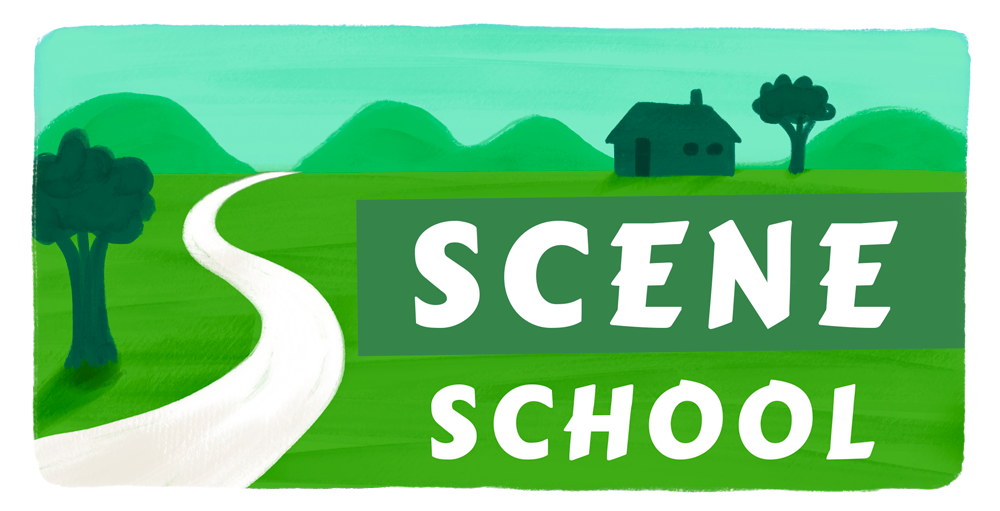
For the next month, we are going to dedicate each entire week to building a single scene. We’ll do this in an easy, approachable way, by researching, drawing, and developing each scene’s component individually before bringing everything together to build an entire scene. I’ll also teach you about drawing fundamentals like atmospheric perspective, background/middle ground/foreground, one and two-point perspective, and more. The types of scenes we’ll be covering are: Nature, Rural, Interior, and Urban.
First, sketch from observation. Try to get an understanding of how the thing looks. You don’t need to be very detailed, just focus on drawing what you see in a simple way without worrying about taking any creative license.
Next, put away your reference and draw from your memory and imagination. Filter the thing you are drawing through your brain and apply some artistic license. For example, If you are trying to draw a palm tree, the goal is to find “your way” of drawing a palm tree. These should also be quick sketches as the purpose is to generate ideas!
Finally, make some notes which ideas you like best! You’ll use these ideas in your finished scene at the end of the week.
First, lay out everything in a rough sketch using basic shapes. For each type of scene, I’ll recommend what order you should add in all the scene components. But generally, you should begin by adding the most massive elements (like land formations, buildings, furniture, etc.) and then incorporate the next largest, and so on, until you’ve added the final details.
Next, Refine your initial sketch, drawing in what all of the final details will look like. This is the stage when you’ll draw everything as you want it to look in the final piece.
Finally, you’ll color and finish your scene. Start by blocking in colors, then add texture, details, and lighting. Stand back, pat yourself on the back for your hard work, and admire your amazing scene!
Your focus for this week’s scene should be a predominately natural environment, with little to no human-made elements. Choose a climate as a jumping-off point! Don’t worry about having your scene fulled flesh out in your head, that is what we’ll spend most of the week doing. Just think about what kind of environment you want to draw.
The first five days are about figuring how to draw the different things that will be in your scene. For example, on “Plants & Trees” day, you should look up pictures of the types of trees and plant life that will be in your scene and learn how you want to draw them. Don’t worry about making a full composition or a finished piece at this point. Figure out how you want to draw your trees and plants so that when you draw the final piece on the last two days of the week, you will know how to depict trees and plants in the scene.
I have included examples below. I decided my nature scene will be inspired by Lake Tahoe a place our family likes to go to often.
What types of living green things exist in your chosen natural environment? Think trees, bushes & shrubs, plants, flowers, cacti, grasses, aquatic plants, etc.
(Swipe to see examples. Tap to expand)
An aquatic element can add a lot of interest to your scene. In what unique ways can you depict the texture and shape of water? Water is Can your scene incorporate one of the following?: river, lake, stream, ocean/coastline, waterfall…or maybe a puddle!
(Swipe to see examples. Tap to expand)
The natural world would not be complete without critters and creatures. Choose one or two to incorporate in your scene. Consider furry friends, reptiles, birds, fish, bugs, etc.
(Swipe to see examples. Tap to expand)
What is the land formation that is characteristic of the environment you’ve chosen? Here are some ideas: mountains, hills, dunes, cliffs, rocks or boulders, canyon, volcano, island.
(Swipe to see examples. Tap to expand)
The sky is an essential part of any outdoor scene and can add a ton of character to a scene. Clouds can come in a lot of shapes and sizes, depending on the weather.
(Swipe to see examples. Tap to expand)
Create a rough sketch of your scene’s layout. In this step you are determining the placement and scale of the different components in your scene. Use basic shapes, like ovals, rectangles, cubes, etc., and leave out the details. Start with the largest parts first and work your way to the smaller elements of your scene. Here is the order I recommend:
In Procreate, reduce the opacity of your initial sketch, then create a new layer. Trace over all the components of your scene, this time drawing shapes and details that you’ll use in your final piece. This is the stage when you’ll draw everything as you want it to look in the final art.
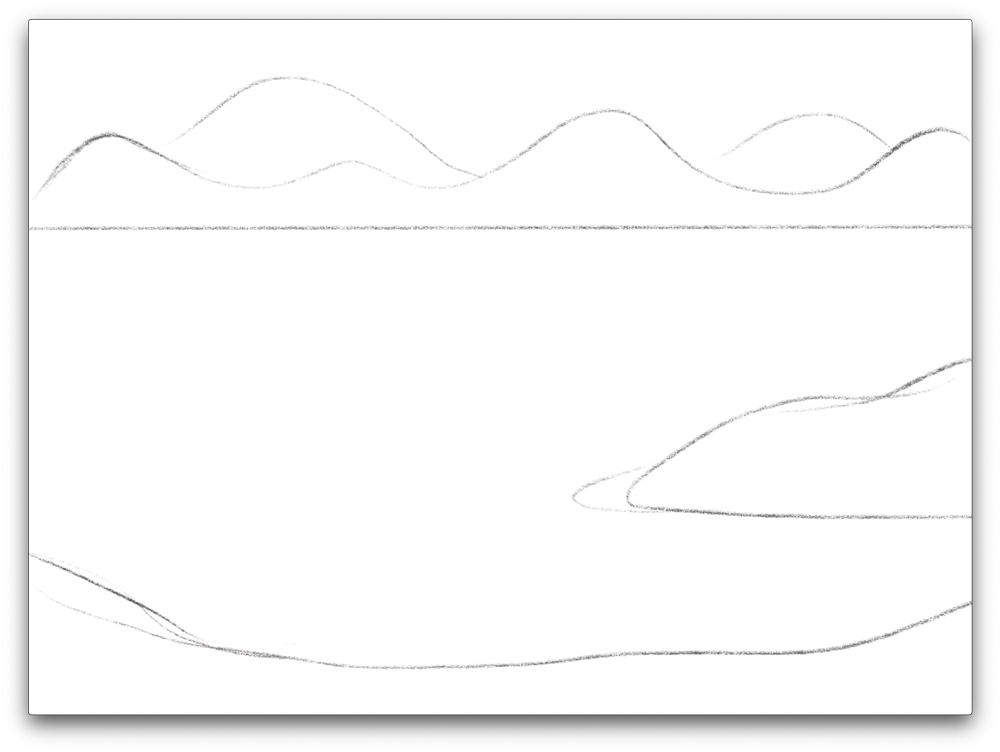
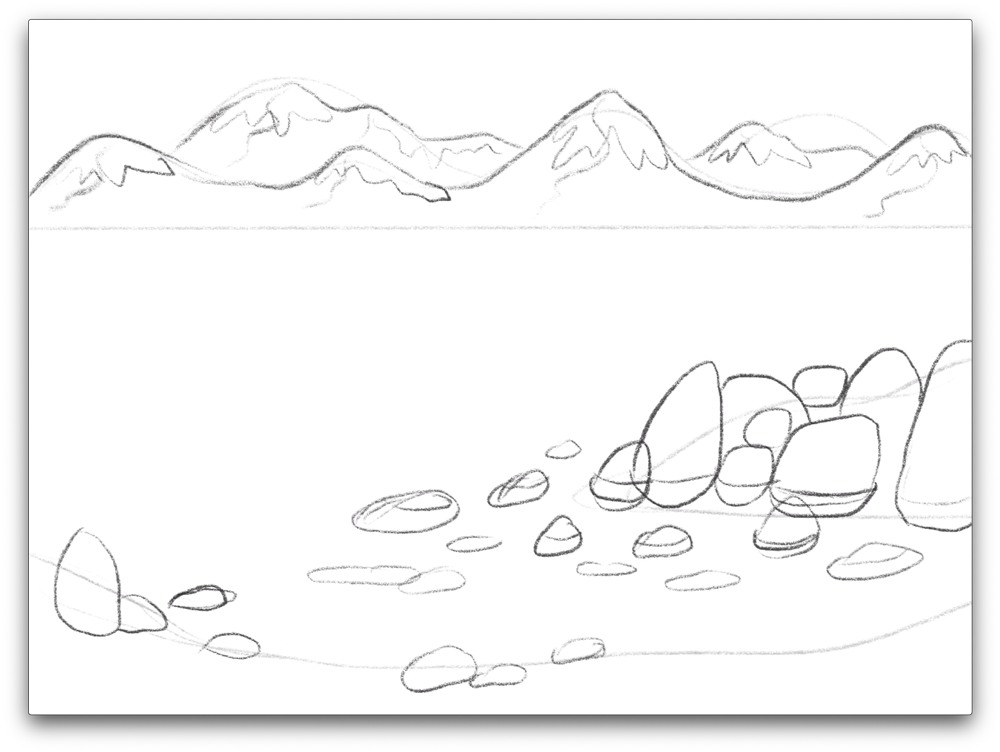

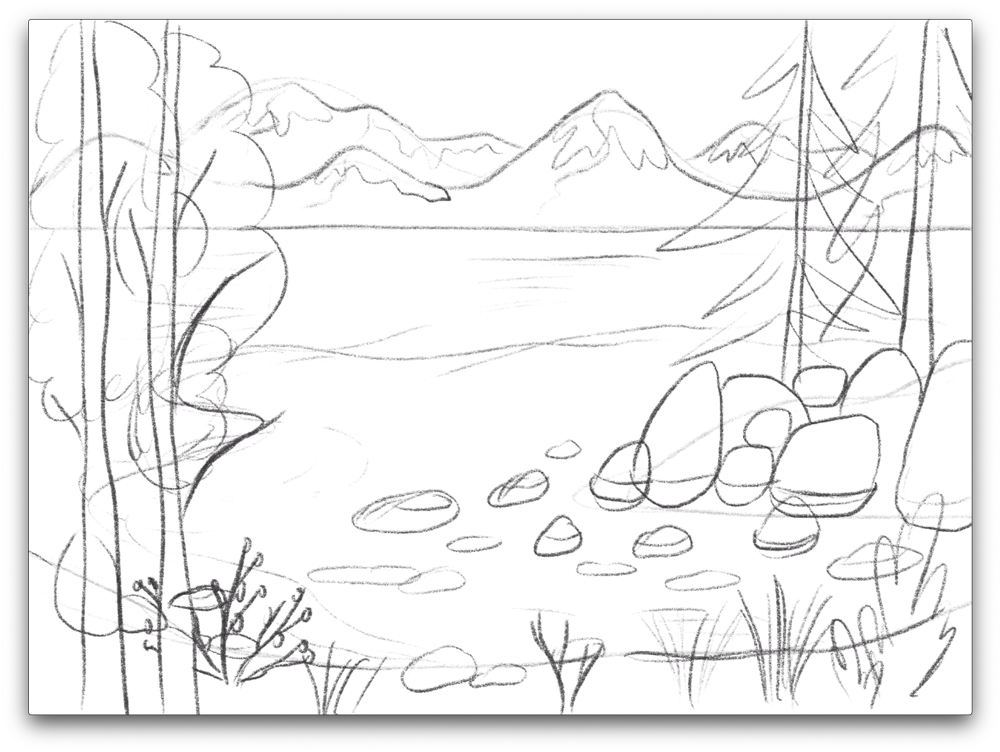


a. Color: Start by coloring in everything in the composition in flat colors. TIP: IF you are unsure about what colors to use, it can help to scribble in colors on a temporary layer to get your color palette figured out.
b. Basic Shading: Apply basic shading to the elements of your scene to give them form and volume. Be sure to consider your light source as you add shading!
c. Texture & Detail: add linework and detail to depict texture and fine details
d. Highlights & Shadows: Finish your piece by adding additional cast shadows created by your light source as well as highlights.
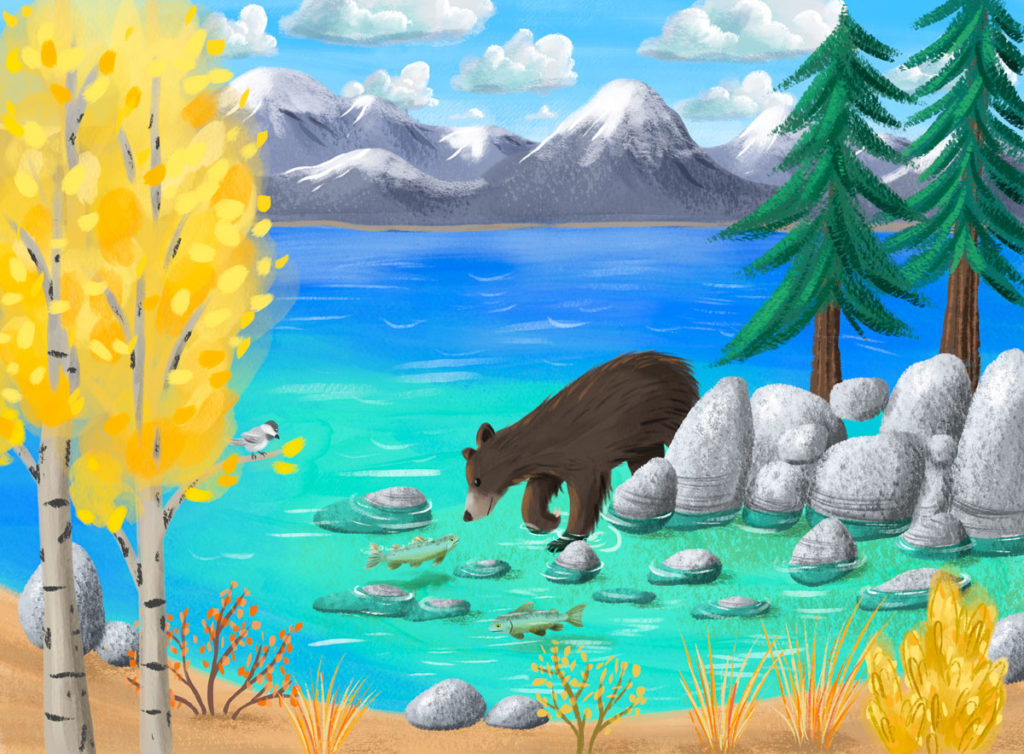
This week for Scene School, you will draw a Rural Scene. This is a mostly natural environment with at least one humanmade structure. After last week, I hope you are a bit more comfortable drawing wild and organic things, so this week we will introduce some inorganic things such as a building, tools, and other objects. My plan for the week is to draw a garden and greenhouse. What will you draw?
The first five days are about figuring how to draw the different things that will be in your scene. For example, on “Plants & Trees” day, you should look up pictures of the types of trees and plant life that will be in your scene and learn how you want to draw them. Don’t worry about making a full composition or a finished piece at this point. Figure out how you want to draw your trees and plants so that when you draw the final piece on the last two days of the week, you will know how to depict trees and plants in the scene.
I have included examples below. I decided my rural scene will be a garden and greenhouse.
Drawing an entire house can be a challenge, so we’ll start by brainstorming styles of doors and windows that will add character to your structure. Look up photos of lots of buildings and houses and draw some of the more interesting doors and windows you see.
(Swipe to see examples. Tap to expand)
Now you get to figure out what your house or building will look like! Make a lot of sketches and try drawing it from a couple of different angles. Spend some time figuring out the colors you want to use as well, but don’t worry about making a fully detailed or finished drawing. Think of this as making a plan for the house you’ll draw in your final art.
(Swipe to see examples. Tap to expand)
This week’s scene will be in a different type of environment than last week, so spend some time today learning about the plant life that exists in your chosen rural setting. Don’t forget to experiment with style too!
(Swipe to see examples. Tap to expand)
The type of building you choose will dictate what kinds of tools and objects might be found in your scene. If it’s a farm, you might find some farm tools, fencing, or a wheelbarrow. At a cabin, you might find piles of chopped wood, an outdoor chair, or a lantern.
(Swipe to see examples. Tap to expand)
Rural settings are largely natural environments, so there will be animals! This week domesticated animals could make an appearance in your scene. Think farm animals, family pets, etc. There may be wild animals too! What creatures will you include?
(Swipe to see examples. Tap to expand)
Create a rough sketch of your scene’s layout. In this step you are determining the placement and scale of the different components in your scene. Use basic shapes, like ovals, rectangles, cubes, etc., and leave out the details. Start with the largest parts first and work your way to the smaller elements of your scene. The order I recommend is above.
In Procreate, reduce the opacity of your initial sketch, then create a new layer. Trace over all the components of your scene, this time drawing shapes and details that you’ll use in your final piece. This is the stage when you’ll draw everything as you want it to look in the final art.
a. Color: Start by coloring in everything in the composition in flat colors. TIP: IF you are unsure about what colors to use, it can help to scribble in colors on a temporary layer to get your color palette figured out.
b. Basic Shading: Apply basic shading to the elements of your scene to give them form and volume. Be sure to consider your light source as you add shading!
c. Texture & Detail: add linework and detail to depict texture and fine details
d. Highlights & Shadows: Finish your piece by adding additional cast shadows created by your light source as well as highlights.
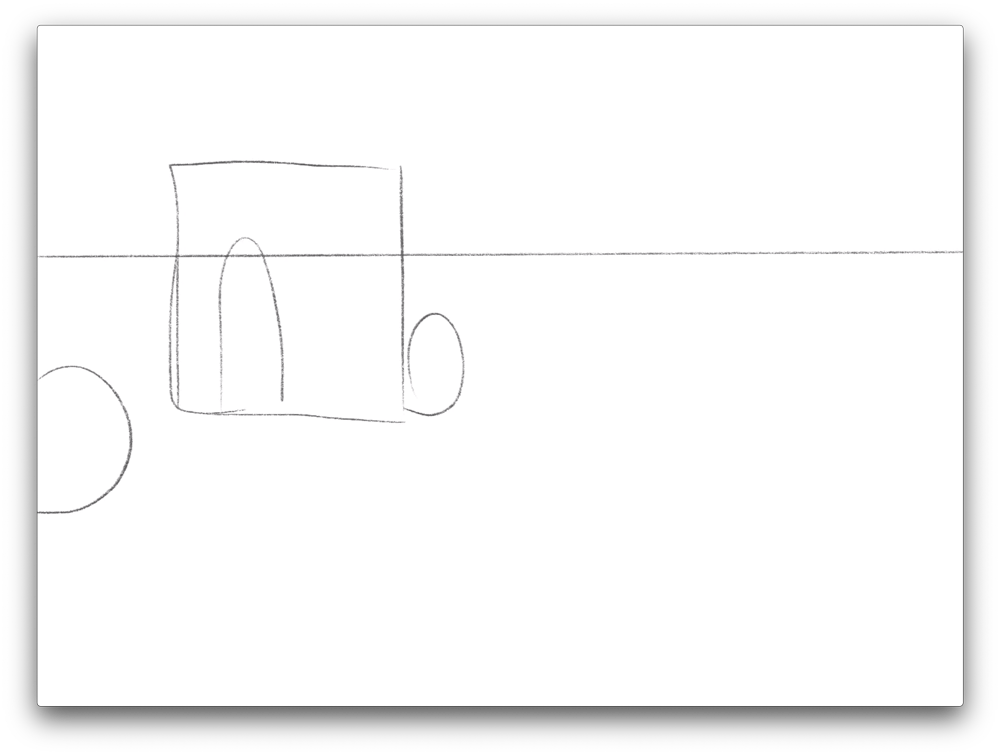

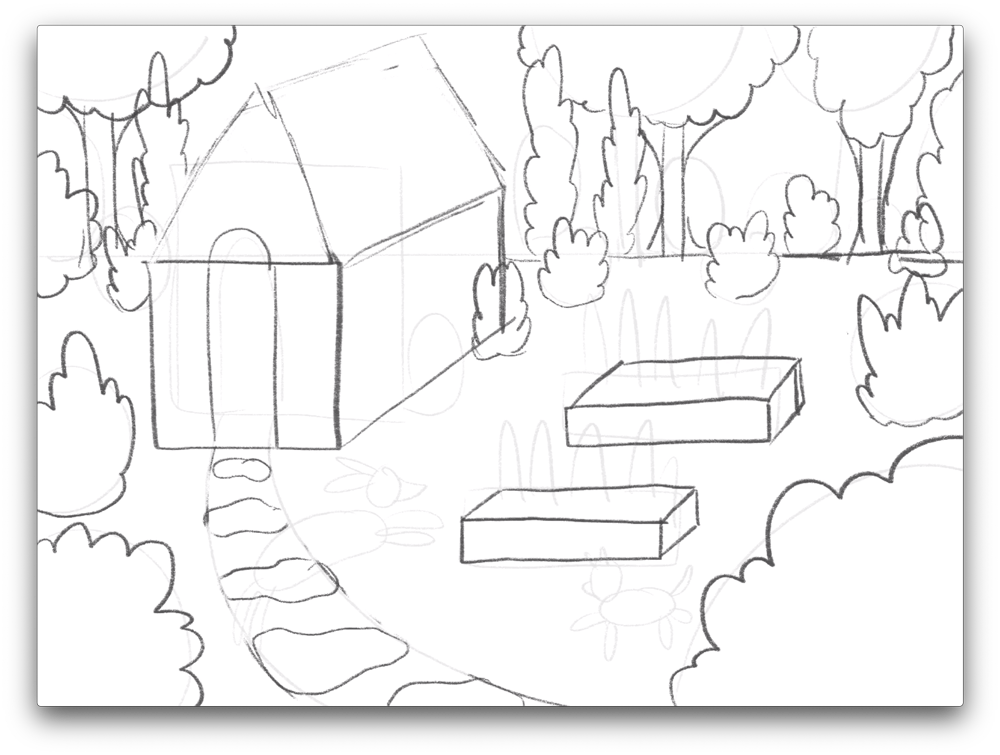
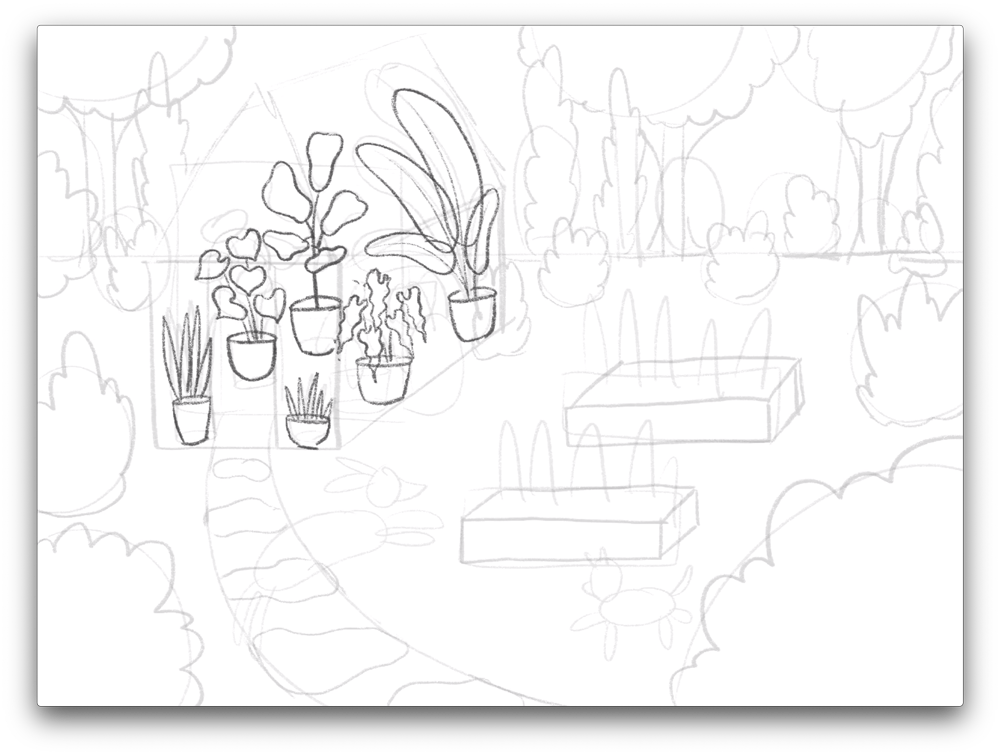
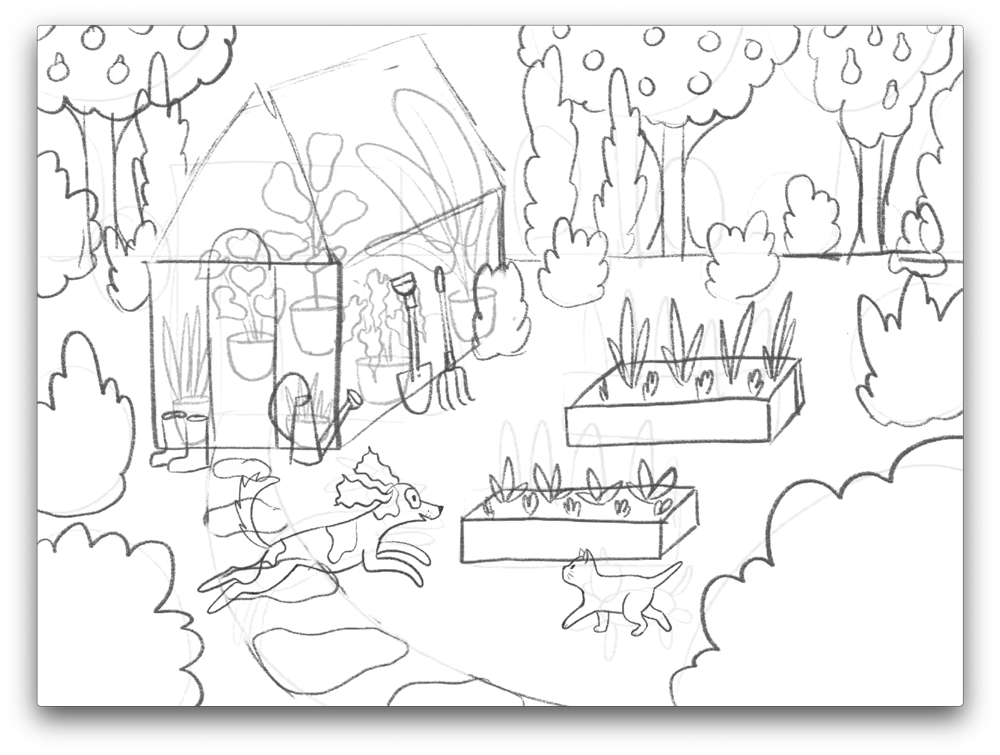
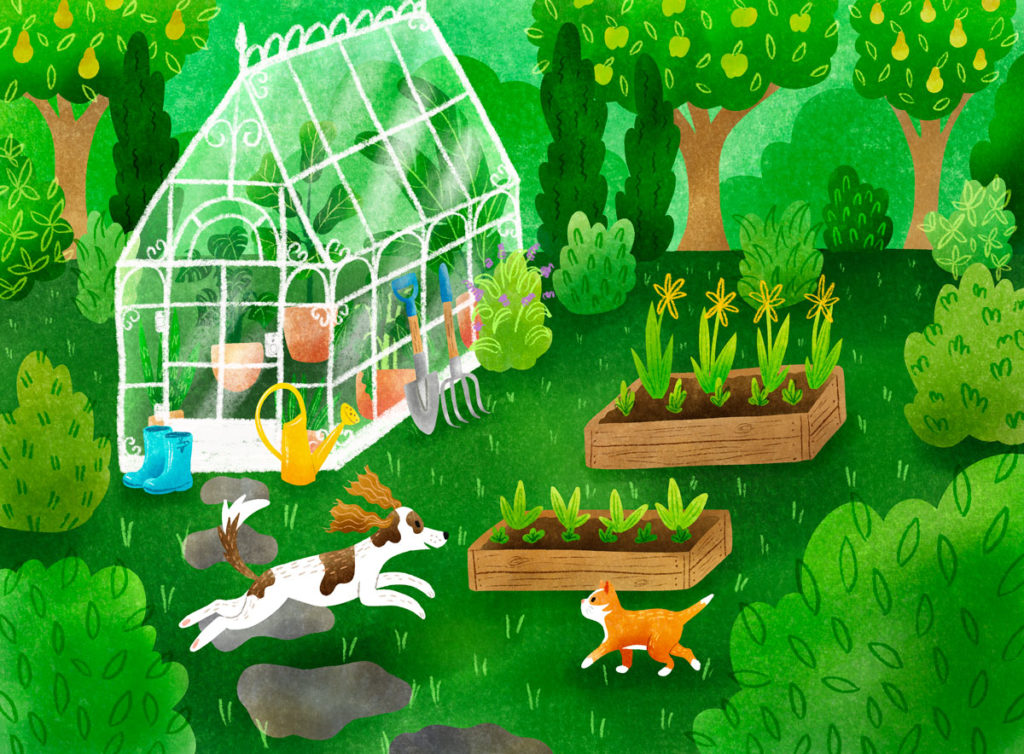
This week’s Scene School Scene School assignment is to draw an Interior Scene. For this, you should choose a room from inside a home such as a living room, kitchen, office, bedroom, bathroom, etc. The question is…who’s house will you be drawing?
One more thing…I’m working on a tutorial about one and two-point perspective that will be out later this week! This information will help you a ton when it comes to drawing your final interior scene. Be sure to subscribe to my YouTube channel, so you don’t miss it!
The first five days are about figuring how to draw the different things that will be in your scene. For example, on “Plants & Trees” day, you should look up pictures of the types of trees and plant life that will be in your scene and learn how you want to draw them. Don’t worry about making a full composition or a finished piece at this point. Figure out how you want to draw your trees and plants so that when you draw the final piece on the last two days of the week, you will know how to depict trees and plants in the scene.
As you are doing your interior scene visual brainstorms, look up lots of photos of furniture and interior scenes. Pinterest is a great search engine to find interesting styles of things. Where do you like to shop for the home? You can also try visiting the site of a home furnishings store you love to get ideas for furniture styles. Or if you are creating a scene based on a room in your home, finding references is as simple as looking around.
Any room you can imagine will home somewhere to sit. What kinds of seating might your room have? Examples: dining chair, rocking chair, office chair, toilet, couch/sofas, bed, etc.
(Swipe to see examples. Tap to expand)
Have some fun with this one! Draw some things that will give the room personality. Examples are wall art, clocks, rugs, pillows, baskets, picture frames, etc.
(Swipe to see examples. Tap to expand)
Bring the outdoors in with some domestic vegetation. Have fun designing containers for your plants! Examples: potted plants and trees, vase of flowers, hanging plants, etc.
(Swipe to see examples. Tap to expand)
In addition to the seating you already drew, what other furniture exists in your room? Some ideas are end tables, appliances, cabinetry, etc.
(Swipe to see examples. Tap to expand)
Every room needs light! The lighting in your room might be used as light sources for shading or just as decorative elements. Examples are lamps, sconces, windows, a ceiling fan, etc.
(Swipe to see examples. Tap to expand)
Create a rough sketch of your scene’s layout. In this step you are determining the placement and scale of the different components in your scene. Use basic shapes, like ovals, rectangles, cubes, etc., and leave out the details. Start with the largest parts first and work your way to the smaller elements of your scene. The order I recommend is above.
In Procreate, reduce the opacity of your initial sketch, then create a new layer. Trace over all the components of your scene, this time drawing shapes and details that you’ll use in your final piece. This is the stage when you’ll draw everything as you want it to look in the final art.
a. Color: Start by coloring in everything in the composition in flat colors. TIP: IF you are unsure about what colors to use, it can help to scribble in colors on a temporary layer to get your color palette figured out.
b. Basic Shading: Apply basic shading to the elements of your scene to give them form and volume. Be sure to consider your light source as you add shading!
c. Texture & Detail: add linework and detail to depict texture and fine details
d. Highlights & Shadows: Finish your piece by adding additional cast shadows created by your light source as well as highlights.
It can be difficult to visualize and layout the elements of a room in three dimensions, so I recommend putting together a two-dimensional floor plan.
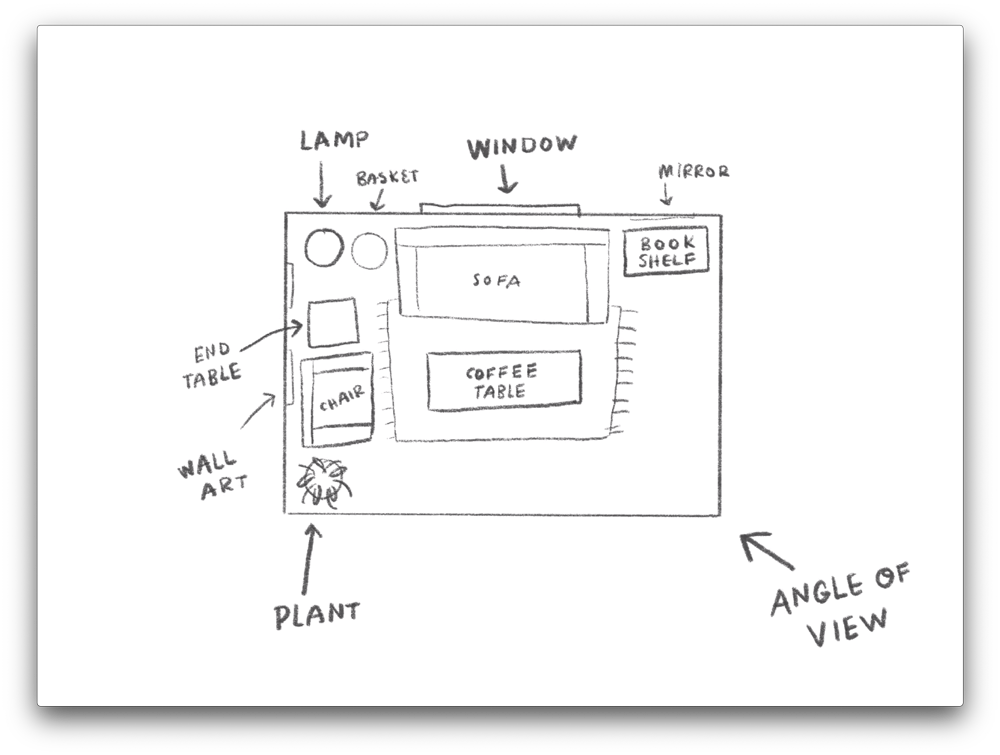
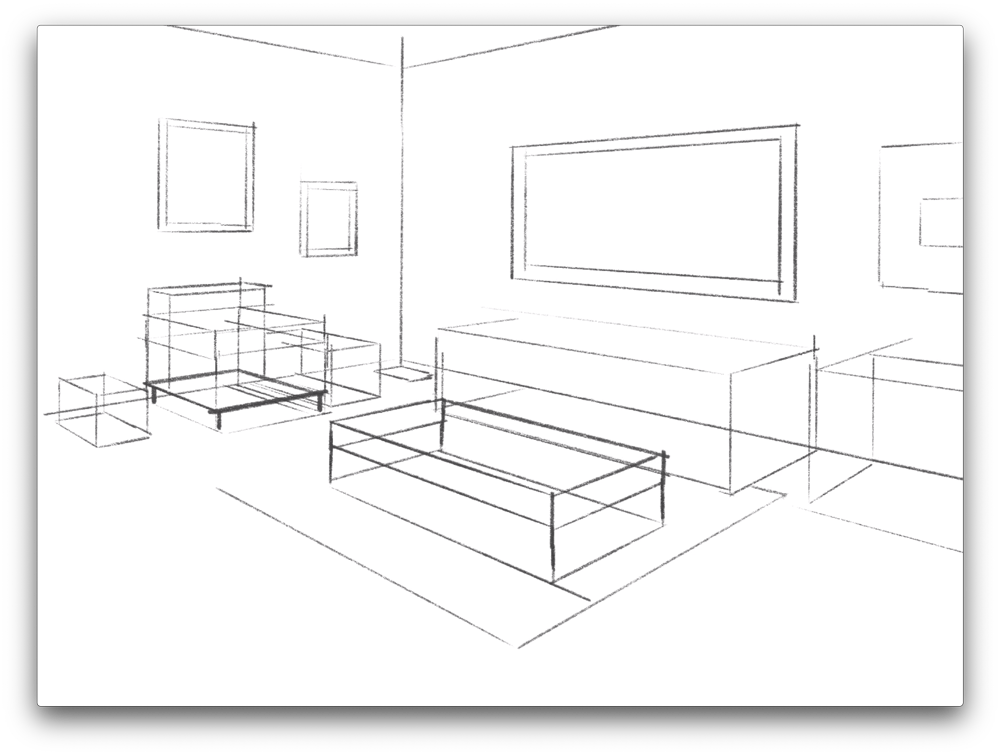
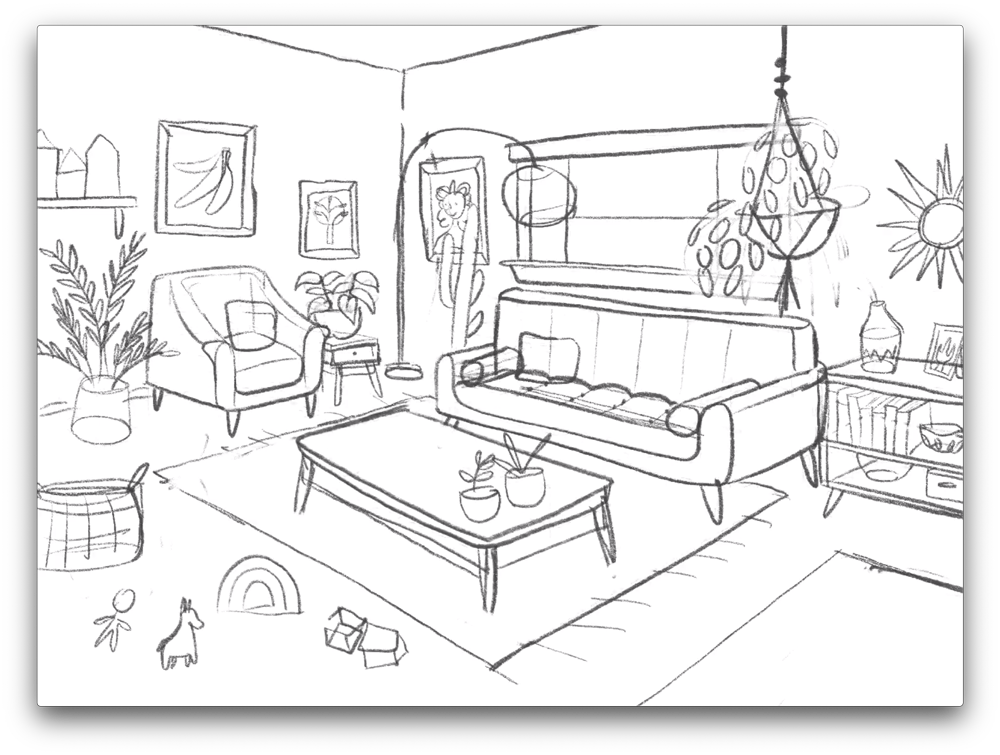
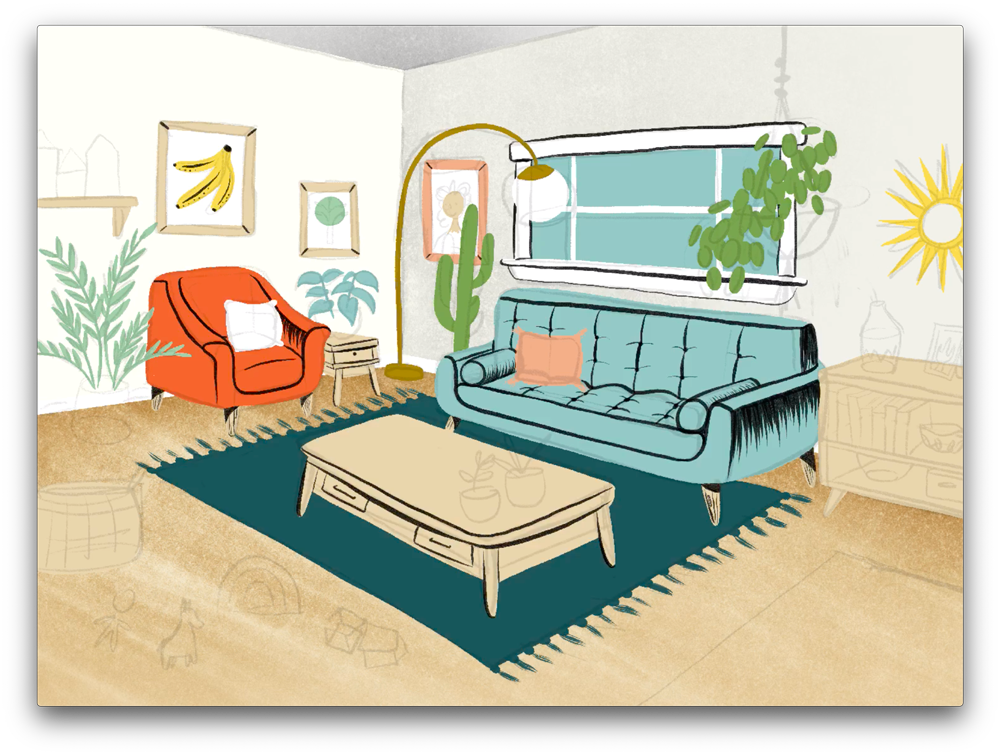

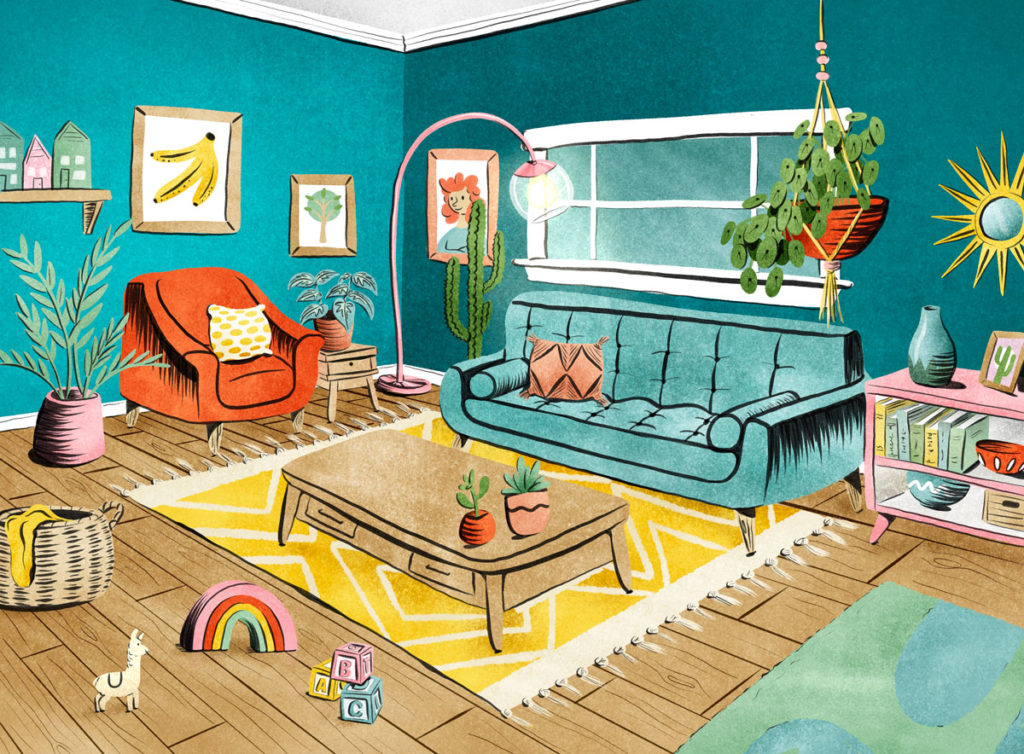
It’s our final week of Scene School…are you ready for some city life? This week we’ll be drawing an urban scene.
For this final week, I’d like you to consider two things for your urban scene: Season and Time of Day
Decide now what season it will be in your scene: winter, spring, summer, or fall? Choosing a season will give your scene a special mood and feeling and help you think of extra details you can include.
The time of day you choose will significantly impact how you choose to draw and render your scene, especially in an urban environment. In the morning or afternoon, buildings and objects will cast long shadows on the ground. If it’s night, you’ll see the glow of electric lights through the windows. What time of day will you choose?
The first five days are about figuring how to draw the different things that will be in your scene. For example, on “Plants & Trees” day, you should look up pictures of the types of trees and plant life that will be in your scene and learn how you want to draw them. Don’t worry about making a full composition or a finished piece at this point. Figure out how you want to draw your trees and plants so that when you draw the final piece on the last two days of the week, you will know how to depict trees and plants in the scene.
Much like we did for Rural week, let’s imagine what will go ON our buildings before drawing the buildings themselves. Today you should draw many different styles of architectural details.
(Swipe to see examples. Tap to expand)
What business will be in all those buildings? A restaurant? Grocer? Dry cleaner? Boutique? Imagine some signage for these shops and establishments and what kinds of things you might see in the windows.
(Swipe to see examples. Tap to expand)
The plant life you might find in the city can be quite eclectic! Consider lots of different trees and plants to sketch. Also, think about the containers these plants might be in: plant pots, balcony planter boxes, tree grates, barriers and fences around plants, concrete planters, etc.
(Swipe to see examples. Tap to expand)
Time to create some buildings! The focus of today’s studies is to brainstorm interesting urban building silhouettes. You can also start to sketch in where some of the details you brainstormed earlier this week.
(Swipe to see examples. Tap to expand)
What city scene would be complete without cars, buses, bikes, and other vehicles? Choose a couple of different types of vehicles to study and sketch today.
(Swipe to see examples. Tap to expand)
Create a rough sketch of your scene’s layout. In this step you are determining the placement and scale of the different components in your scene. Use basic shapes, like ovals, rectangles, cubes, etc., and leave out the details. Start with the largest parts first and work your way to the smaller elements of your scene. The order I recommend is above.
In Procreate, reduce the opacity of your initial sketch, then create a new layer. Trace over all the components of your scene, this time drawing shapes and details that you’ll use in your final piece. This is the stage when you’ll draw everything as you want it to look in the final art.
a. Color: Start by coloring in everything in the composition in flat colors. TIP: IF you are unsure about what colors to use, it can help to scribble in colors on a temporary layer to get your color palette figured out.
b. Basic Shading: Apply basic shading to the elements of your scene to give them form and volume. Be sure to consider your light source as you add shading!
c. Texture & Detail: add linework and detail to depict texture and fine details
d. Highlights & Shadows: Finish your piece by adding additional cast shadows created by your light source as well as highlights.






We’ll stock your inbox with Procreate tips, new releases, and free goodies!
Bardot Brush was created by California-based illustration artist, teacher, and all-around creative person, Lisa Bardot.

©2022 Bardot Brush by Lisa Bardot // All Rights Reserved